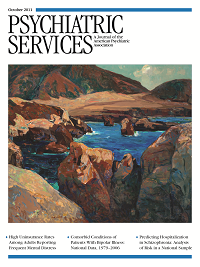Trajectories in Use of Substance Abuse and Mental Health Services Among Stimulant Users in Rural Areas
Abstract
Objective:
This study examined substance abuse and mental health service utilization during a three-year period among stimulant users living in rural areas.
Methods:
Participants (N=710) were interviewed at baseline and every six months for 36 months. One-step transition probabilities were constructed between the two types of service use for each consecutive pair of interviews to examine the resulting steady-state probabilities among multiple one-step transition matrices.
Results:
Most participants received no substance abuse or mental health services. On average, the probabilities of reporting use of the same types of services during the 36-month follow-up were 82% for receiving neither service, 9% for receiving only mental health treatment, 6% for receiving only substance abuse treatment, and 2% for receiving both services.
Conclusions:
Further study is needed to determine factors that affect the decision to seek mental health or substance abuse treatment among residents of rural communities. (Psychiatric Services 62:1230–1232, 2011)



